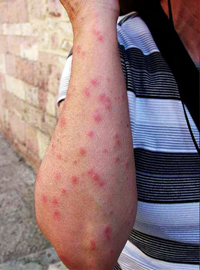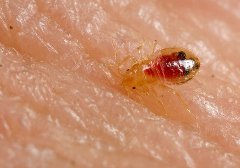|
|
The Educated Traveler's COMMON SENSE Guide to Effective Bed Bug Control
|
|
 Bed bugs have returned in epidemic numbers. They
are by far one of the most difficult (and most costly) insects
Bed bugs have returned in epidemic numbers. They
are by far one of the most difficult (and most costly) insects
to control. And to make matters worse, it’s very
difficult to detect them. Anyone who
has ever been bitten by these tiny
“hitchhikers” will do everything possible to keep it from
happening again.
(left picture credit to Urbanentomology.tamu.edu)
If you are planning a trip, please read this article and
follow the very basic protective steps to keep you bed bug free at
your destination, and to insure you don't bring
these little "hitchhikers" back home with you.
Spray the inside
and the outside of your luggage with OFF mosquito repellent. This
will help deter the bed bugs from sneaking into your luggage while at your destination.
If travelling by
car be sure to take large sealable plastic bags. These will be used
to encase and seal the luggage before you place these items back into the car on your return trip. This will
greatly reduce bed bugs from infesting your car. Further information will be given in the
UPON YOUR RETURN section
below.
Your
suitcases should be hard-shelled. Fabric or cloth type luggage pieces are bed bug friendly. Large sealed Ziploc type bags should be packed to store your clothing while at your
destination. Smaller sealed Ziploc type bags should also be packed for electronic items and other items that
cannot be laundered. Yes, these tiny “hitchhikers” can
infest these items also.
Before we go into detail I need to warn you
that if you do not follow these basic steps you are
asking for “bites”. They may not prevent you from taking the
little “hitchhikers” home but at least your odds will be improved.
Inspect the
bed. Pull back sheets and inspect around the
edges. If you see bed
bugs immediately NOTIFY MANAGEMENT and ask for another room well away from the infested room. Even if
you see any tiny spots (blood
spots) ask for another room. Don’t take any
chances.
Keep luggage on
the floor at least five feet from the bed. Never put these items in the closet, or on
the bed. Even the luggage stand could be infested.
If you put your
clothing into dresser drawers, be sure to put them into sealed plastic
bags first. Many a dresser and
night stand have been infested by bed bugs.
Computers and
other electronic items that can't be
laundered should be placed in sealed bags (such as Ziploc bags)
when not in use.

(Engorged bedbug after a blood meal)
The very basic steps you have taken may have been enough to prevent you from
bringing the
“hitchhikers” home. But
don’t count on it. The following precautions are the most critical.
|
Unpack Carefully In This Manner
|
|
First you must
place the luggage and other items on the garage floor or back patio
well away from beds and furniture. If you travelled by car this is where you
remove each piece of luggage from its sealed bag, place it on the
floor and empty contents. Do each piece of luggage separately. Throw bags away in outside a trash
can.
Now we must deal
with clothing. Items that must
be laundered should placed in sealed bags until they are washed. The temperature should be at least 140 degrees.
Items that must be dry cleaned should be placed in sealed bags
until cleaned.
All other items
which cannot be laundered (which includes the luggage containers
themselves) should be placed in heavy duty lawn bags. A pest strip containing DDVP/Vapona should be placed
inside. Seal the bag firmly and leave it alone for at least two weeks. These strips slowly emit a chemical which will kill any of
the tiny “hitchhikers” that may be inside.
The information given above contains only the most basic
precautions you must take. Obviously we don’t expect you to spend all your time looking for
possible bed bug infestations. A thorough bed bug inspection
involves checking the entire room including behind the headboard of the bed, in the dresser drawers, the
closet, behind the baseboards, inside electrical outlets, etc. It
takes a trained professional pest control technician hours to properly inspect a room. These
tiny insects can get into the smallest cracks and crevices. Sometimes the management will replace the
mattress and not properly treat the entire room. Many a traveler has been rudely awakened to “itching”,
and even worse actual bed bug “bites”. If you pay attention to the above
advice you stand a good chance of leaving the tiny “hitchhikers’
behind.
Two VERY IMPORTANT reasons why you
need bed bug proof mattress encasements.
*You may bring bed bugs into your home yourself. *Your guests may bring them into your home.
The Protect-A-Bed is the only mattress encasement which
is proven bed bug proof. A special zipper
lock is what makes the difference. All other mattress encasements failed to keep bedbugs in or out
either because the zipper teeth were too big or the zipper itself didn’t close
properly.
Protect-A-Bed AllerZip® mattress protector has a warranty for 10 years against fabric and manufacturing
defect. CALL
Termpest FOR PRICES.
Termpest
- a full service termite and pest control company giving you no nonsense
common sense solutions all the
time.
Florida Tri-County area - 305-895-6430
Global - 866-312-PEST
(7378) |
 Bed bugs have returned in epidemic numbers. They
are by far one of the most difficult (and most costly) insects
Bed bugs have returned in epidemic numbers. They
are by far one of the most difficult (and most costly) insects